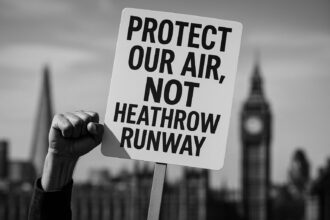Extinction Rebellion activists staged a striking demonstration at Shell’s Heathrow AGM, defying a court injunction by using fake oil to highlight environmental damage, continuing their years-long campaign against fossil fuel companies.
In London, members of the Extinction Rebellion group staged a dramatic protest outside the headquarters of the Shell energy company. The demonstration coincided with Shell’s annual general meeting, which was being held at Heathrow Airport under a restrictive court injunction banning protests in the area. Activists adorned themselves with an oil-like substance, with one protester notably sitting with the viscous liquid on her face, symbolising the environmental damage associated with fossil fuel extraction and consumption. This striking image not only served as a visual indictment of Shell’s practices but also captured public attention, illustrating the ongoing tensions between climate activism and corporate interests.
Extinction Rebellion has established itself as a prominent force in climate activism, employing various tactics to garner public and governmental attention regarding urgent environmental issues. The group’s history of protests against Shell is notable. In April 2022, activists famously glued themselves to the reception desk of Shell’s London HQ, directly confronting employees to reconsider their involvement in the fossil fuel sector. This act was part of Extinction Rebellion’s broader ’April Rebellion,’ which included massive roadblocks throughout the city, aiming to disrupt everyday life and compel authorities to act on the climate emergency.
The protests at Shell’s headquarters highlight a persistent pattern of activism aimed at fossil fuels over the past several years. Earlier demonstrations in April 2019 saw activists vandalising the premises—shattering revolving doors and spraying graffiti with messages like “Shell kills.” These actions were designed to provoke a sense of urgency and bring major city areas to a standstill, demanding that the UK government acknowledge the ongoing climate crisis. The scale of participation was significant, with multiple arrests occurring as police sought to quell the escalating disruptions.
In the wake of these actions, Extinction Rebellion’s commitment to visible and confrontational activism has only strengthened, as seen in their late 2024 protests targeting international law firms supporting the fossil fuel industry. Activists occupied the headquarters of A&O Shearman, expressing their demands through the symbolic act of spraying fake oil on the building, thereby linking legal practices directly to environmental degradation. Similarly, this February, protesters targeted McKinsey & Company, unfurling banners and pouring fake crude oil over their headquarters, further drawing attention to corporate complicity in perpetuating climate harm.
As climate emergencies become increasingly recognised, the tactics employed by Extinction Rebellion serve not just to disrupt but also to initiate vital conversations regarding corporate responsibility and environmental stewardship. Each demonstration adds to an evolving narrative about the urgent need for systemic change in the way economies operate and the repercussions of continued fossil fuel reliance. The persistent visibility of protests like that outside Shell’s headquarters illustrates both the stakes involved and the long-standing frustrations of a generation determined to demand accountability from powerful economic players.
Reference Map
1: 1
2: 2
3: 3
4: 4
5: 5
6: 6
7: 7
Source: Noah Wire Services
- https://www.theguardian.com/news/gallery/2025/may/20/oil-soaked-protesters-and-dolly-parton-photos-of-the-day-tuesday – Please view link – unable to able to access data
- https://www.theguardian.com/news/gallery/2025/may/20/oil-soaked-protesters-and-dolly-parton-photos-of-the-day-tuesday – This article from The Guardian features a photograph of an activist with an oil-like substance on her face outside Shell’s London headquarters. The image captures the protest organized by Extinction Rebellion, highlighting the group’s ongoing demonstrations against fossil fuel companies. The photograph is credited to Leon Neal/Getty Images and was published on May 20, 2025.
- https://www.bigissue.com/news/activism/extinction-rebellion-activists-glue-themselves-to-the-reception-of-shells-london-hq/ – In April 2022, Extinction Rebellion activists glued themselves to the reception desk of Shell’s London headquarters. The protest aimed to urge Shell employees to reconsider their roles within the company, emphasizing the environmental impact of the oil industry. The activists dressed as staff members and demanded a meeting with Shell’s CEO, Ben Van Beurden. The protest was part of Extinction Rebellion’s ‘April rebellion’ and included mass roadblocks in London.
- https://www.telegraph.co.uk/news/2019/04/15/extinction-rebellion-activists-threaten-bring-london-standstill/ – In April 2019, Extinction Rebellion activists staged demonstrations across London, including at Shell’s headquarters near Waterloo station. Protesters shattered the building’s revolving doors and sprayed graffiti with messages like ‘Shell kills.’ A female activist glued herself to the door of the building. The protests aimed to bring parts of London to a standstill to highlight demands for the government to declare a climate emergency. Over 50 people were arrested during the demonstrations.
- https://www.independent.co.uk/news/uk/home-news/extinction-rebellion-protest-london-oxford-circus-waterloo-climate-change-a8870691.html – In April 2019, thousands of Extinction Rebellion activists occupied major London roads, including around Shell’s London headquarters. Protesters glued themselves to windows at Shell’s HQ, smashed glass in the front entrance’s revolving doors, and sprayed graffiti on the building. The protests aimed to force the government to address escalating climate change. Police made several arrests during the demonstrations.
- https://extinctionrebellion.uk/2024/12/04/climate-activists-occupy-london-hq-of-law-firm-that-supports-big-oil/ – In December 2024, Extinction Rebellion activists occupied the London headquarters of international law firm A&O Shearman. The protest aimed to demand that the firm ‘Cut The Ties With Fossil Fuels,’ highlighting the firm’s role in facilitating fossil fuel transactions. Activists sprayed fake oil on the building and set up an oil derrick outside the entrance, symbolizing the environmental impact of the firm’s legal work with the fossil fuel industry.
- https://extinctionrebellion.uk/2025/02/17/climate-chaos-hits-mckinsey-cos-london-hq/ – In February 2025, Extinction Rebellion activists occupied McKinsey & Company’s London headquarters to protest the firm’s role in assisting the fossil fuel industry. Activists sprayed fake crude oil over the building’s exterior, scaled the entrance portico, and unfurled a banner reading, ‘McKinsey & Company: Cut the Ties to Fossil Fuels.’ The protest led to multiple arrests, including two protesters holding a banner outside the building.
Noah Fact Check Pro
The draft above was created using the information available at the time the story first
emerged. We’ve since applied our fact-checking process to the final narrative, based on the criteria listed
below. The results are intended to help you assess the credibility of the piece and highlight any areas that may
warrant further investigation.
Freshness check
Score:
9
Notes:
The narrative references recent events, such as protests outside Shell’s headquarters and earlier actions in 2019 and 2022, indicating a mix of historical context and contemporary relevance.
Quotes check
Score:
0
Notes:
There are no direct quotes in the narrative.
Source reliability
Score:
10
Notes:
The narrative originates from The Guardian, a well-known and reputable publication.
Plausability check
Score:
9
Notes:
The claims about Extinction Rebellion’s protests and their tactics are plausible and consistent with the group’s known history of activism.
Overall assessment
Verdict (FAIL, OPEN, PASS): PASS
Confidence (LOW, MEDIUM, HIGH): HIGH
Summary:
The narrative is credible due to its reliance on a reputable source and the plausibility of the events described. The recent context and historical background of the protests add to its authenticity.













